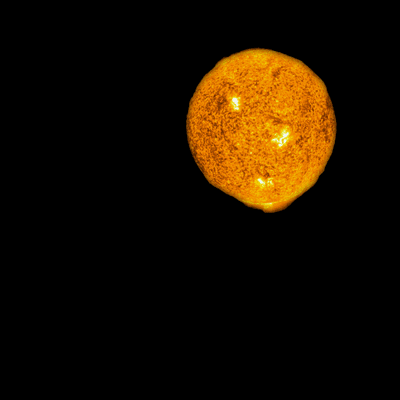Blog
Sky Full of Fire
4 January 2014
Sometimes in astronomy a simple question can have a complex answer. For example, why is the night sky dark? You might think that has an easy answer: the sky is dark because the stars are very far away and appear dim. It’s obvious why the sky is dark, right?
Except it isn’t.
 Wikipedia user Kmarinas86
Wikipedia user Kmarinas86In actuality, stars are quite bright. Many of them are as bright or brighter than the Sun. They only appear dim because they are far away. But there is an interesting catch. The apparent brightness of a star decreases with distance according to the inverse square law. In other words, it two stars have the same absolute brightness, but star A is twice as far away as star B, then star A will appear one fourth as bright. The catch is that the apparent size of a star also decreases according to the inverse square law. This means that while a distant star appears dimmer, it also appears equally smaller. Thus you could argue that a star appears as bright as the Sun, but just over a tiny area.
So if the universe is an endless sea of stars, then if we look in any direction in the night sky we will see a star. That star may be very, very far away, but in that one precise direction the night sky is as bright as the Sun. Of course for an endless sea of stars, that should be true for any direction we look. If the universe goes on forever, then the night sky should be a blaze of light, as seen in the animation below.
This is often known as Olbers’ Paradox, after Heinrich Olbers, who popularized the question in the early 1800s. For about a hundred years it was a real mystery.
Now you might think the answer to this paradox lies in the fact that the universe is not an endless sea of stars. Stars are clumped into galaxies, after all. But this doesn’t solve the paradox. Instead it simply pushes the paradox from stars to galaxies. The apparent brightness and size of galaxies follows the same inverse square law, so an endless sea of galaxies would also produce a blazing bright sky.
What about the fact that there is lots of dust in the universe. The dust doesn’t give off light like stars, so that should solve the paradox. It doesn’t because the dust would absorb light and heat, so if the dustless regions of sky were as bright as the Sun, the dust would be heated to the same temperature and would therefore give off just as much light as the stars.
Olbers’ paradox makes two assumptions about the universe. The first is that it goes on forever, the second is that it has always existed. While the first assumption might be true, the second assumption is not true. The universe is expanding, and it began about 13.77 billion years ago with the big bang. Since the universe has a finite age, and light travels at a finite speed, there is a limit to how far away visible stars and galaxies can be. Light from more distant galaxies simply hasn’t had time to reach us. Also, since the universe is expanding, the light from distant stars is redshifted, making them appear cooler than they actually are. So the night sky is dark precisely because the universe is expanding and has a finite age.
When you look at a dark night sky, you are seeing evidence of the big bang.